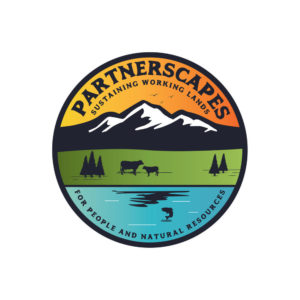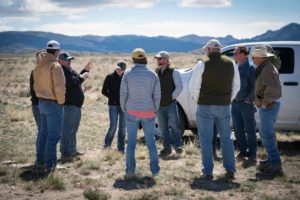Welcome to our profile series “Collaboratives Behind-the-Scenes.” This series features Q&As with different conservation organizations to provide a view into what it takes to run a collaborative organization: from challenges faced in building partnerships, to tips for budding organizations. Whether you’re already running a collaborative and are looking to increase your efficiency, or are thinking of starting a collaborative but want to know more about what you’re getting into, we hope you find this series insightful!
Partnerscapes works under the mission of bringing “people, working landscapes and communities together in conservation.” To do this, they work across the country to connect private landowners with a network of public agencies, nonprofit conservation groups, policymakers, and others. You may be familiar with their Landowner Forums or Private Lands Partners Day, events focused on sharing landowners’ experiences and stories to bring different interests together in the name of conservation. Partnerscapes is a registered 501c3 and largely a volunteer-led organization, with a strong board and limited staff.
Steve Jester, Partnerscapes’ Executive Director, took time to talk with us about his experience participating in collaborative conversation at Partnerscapes, including about staying mission focused, the importance of relationship building, and employing empathy.
Note: This conversation has been edited for clarity and length.
How did Partnerscapes get started? 
Around 2006, a local landscape group in Western Montana called the Blackfoot Challenge was awarded a grant to try and move their model of collaborative conservation, landowner-led conservation, across the country. The first thing they did was hold a couple of meetings and bring together people from different parts of the country doing similar types of work. At that time, there wasn’t a mechanism connecting these different groups. After a couple of years of finding more and more of these landowner-led groups, in 2010, the decision was made to form an organization — Partnerscapes.
To this day, all of the board of directors and partners for conservation are landowners whose purpose for being involved is their strong support for public-private partnerships based on the results that they’ve seen in their landscapes and in their local, rural communities. They decided to start using their storytelling, their experience with this approach, to make it more accessible and more widely adopted across the country.
I think the thing that’s unique about us and the way we work is our board is a working board in the true sense of the term. What we have to offer to the conservation community is what’s in the minds, hearts, and experiences of the men and women doing this work from a local perspective, from a landowner perspective.
In thinking of how you got started, what tips can you offer newer conservation groups that are just starting to form?
I’ve had a number of positions prior to this in the public sector, and the nonprofit sector, and the private sector. One thing that I constantly see that trips up organizations is mission creep and trying to do too much. A lot of nonprofits feel pressured to do this.
Once you start growing, you’re increasing your fixed costs and your need for logistical support. We start expanding or looking at projects or opportunities solely as a way to help pay the bills. You get on a mouse wheel where you’re running faster and faster and faster, and you’re not going anywhere. You’re growing to service the commitments that you’ve made as opposed to the mission that was at your formation. And then your mission starts flopping around all over the place depending on where the money’s coming from, what the issues of the day are.
I think a lot of groups don’t really think about that when they’re starting out. “Well we could add this, we could pick this up because this will help us pay for our office space or this employee over here.” But is it a part of what you were established to do and part of your core mission?
How do you measure if you’re being successful? And how do you share those stories of success?
It’s really pretty tough. I think for us, we talk to a lot of people, we encourage, we cajole, we try to provide support, information for those within organizations that want to do more of this type of work. Progress is pretty incremental most days. A lot of it is trying to engage people at all levels of these organizations and trying to get them involved in the hope that at some point in the future, if they really buy into it, they’ll be in a position to wield broader influence. It’s a long game.
We have individual anecdotes of people telling us, “You guys made a difference here,” “I’m sure glad your landowner was here to talk to this group because they didn’t even want to talk to each other before, but now they’re willing to give it a try.” When you’re talking about people and their attitudes and their actions as opposed to acres and dollars on different types of projects, for a trained biologist and agriculturalist like myself, it’s hard to develop things that you’re comfortable with as metrics.
But I do know that 30 years in the business tells me that the easiest way to take $10 million worth of investment and turn it into $1 million in conservation is to try to move forward without productive relationships and partnerships in place. Conversely, I’ve seen many places where the relationships were in place where they took $1 million of investment and turned it into $10 million of conservation.
Relationships are something you have to have for those successes, but it’s never the focus of what people look to when they say, “What have you accomplished here? What’s the secret to your success?” A lot of people will say, “Well, we had great partners,” but that glosses over the relationship building, the trust building, the credibility building among the partners that had to go on before you could move forward with that work.
Do you have one or two other tips to offer conservation groups when they’re forming partnerships, whether that be with individual landowners, federal agencies, the people that Partnerscapes works with?
One of the big ones is you need to invite everybody on the front end. If you do, even if they don’t show up, you can always say, “We tried to get these folks involved, but at the time they chose not to.” And if you don’t invite them, there will be some validity if they say, “Well I wasn’t involved. Nobody asked us. Where is my perspective or the perspective I represent in all this?”
These partnerships only move as fast as the most important partner. And while all partners are important, say it’s a 90 percent private landscape; If the landowners are not at the table, you’re going to have a hard time getting anything done. Conversely, if it’s a 90 percent public land landscape, and the BLM and Forest Service (just as examples) are not on board, you’re going to be limited on what you can expect to accomplish no matter what you’re working on.
And you have to build in time on the front end for that relationship building before you jump right in on planning or doing projects. If you don’t, then let’s just say this partnership is forming because somebody got a grant and we finally can organize something and give it a name. Hopefully, you’ve been working on your partnerships all along and this is just an opportunity to leverage up. But if you form a partnership in response to a funding agreement or a crisis level challenge and you don’t put in the time building those relationships, the partnership will only last as long as the grant money is there or only as long as the bridge is on fire. If you want to have true collaborative, community-based conservation, it’s something that transcends any particular grant program or any particular authority of one organization. It’s based on relationships.
How do you get stakeholders involved in your work?
You have to meet people where they are. You have to find a way to have empathy and understanding for somebody’s perspective even though you don’t share it. And then you try to look for the overlap between the perspectives.
This whole idea of collaborative conservation, in my mind anyway, is not more complex at its core as the golden rule is: treat others as you would like to be treated. If you’re going to work with somebody, it’s not just about being nice and not being mean. It’s also trying to put yourself in their place so you can understand what they’re dealing with.
In the case of private landowners, their bandwidth is stretched to the limit. Conservation is an important part of what they do, but they have families, they have bills to pay, they have to think about what the county is doing, what the state is doing, all the things that affect their land ownership experience. Be respectful of your potential partners and stakeholders and empathize with what they have to deal with.
I think usually, if they have overlap with you and share values for a place, don’t get hung up on the fact that they value it for a different reason than you do, that that’s somehow less pure or less valid. I think it’s really no more complex than that.
As Partnerscapes has always worked remotely, Steve had this thought to share about organizations forming during the pandemic.
We’ve always worked remotely and always worked on the phone, but we always had the ability, a couple of times a year, to gather as a group to move the big rocks. You would think that an organization that was built on remote participation would have an easier time than one that’s used to meeting every third Thursday in the local library. But it’s been just as challenging for us to maintain the passion and the momentum [during COVID].
I think it would be a disservice not to tell that to organizations, particularly those that are in the period of formation or very young organizations that may have started organizing since the pandemic began. I know for us, we [see] a return [to] normal as one of the least likely scenarios of ever getting back to. So how are we going to do our work in the future? I think the world has changed in a lot of ways when it comes to people gathering and it’s going to be something we’re all going to have to incorporate into the establishment of new organizations.
###
Thank you Steve Jester for sharing your experience and reflections!
Find out more about Partnerscapes on their website.
Share your thoughts and engage in a conversation about this piece using our Western Collaborative Conservation Network listserv.


